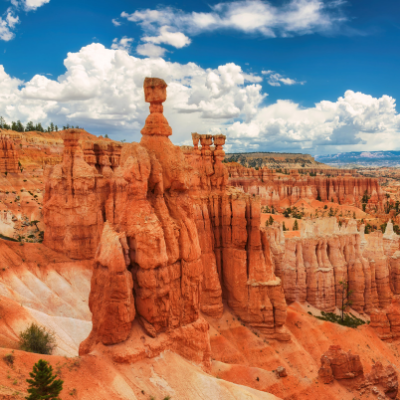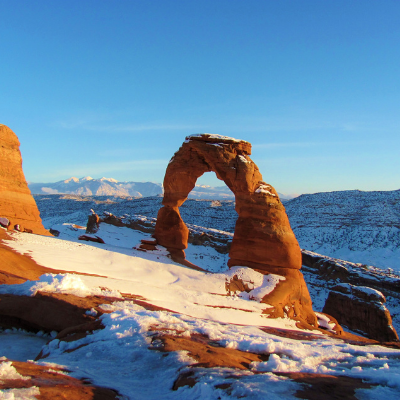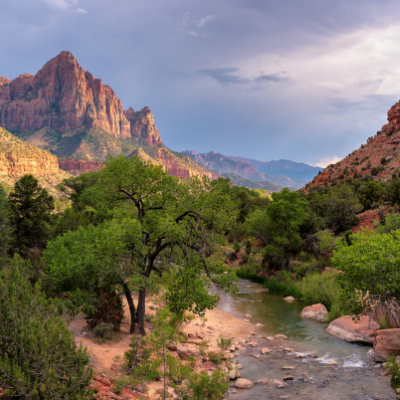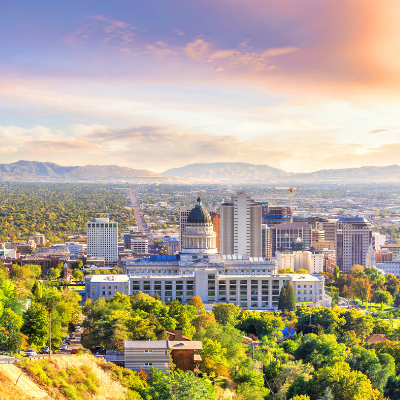Moving to Utah Guide: Discover the Beehive State
We created this guide for moving to Utah to help those who are in the early stages of researching where they’d like to move. So, what exactly do you need to know before moving to Utah? We’ve compiled some of the most important items you should know and consider when making this big decision. According to 2020 Census data, Utah was the fastest growing state of the decade, with a whopping 18.4% growth in population. Is Utah the right state for you to move?
What You Need to Know about Utah’s Geography

Utah is a western state bordered by Idaho, Wyoming, Colorado, Arizona, and Nevada. The southeastern corner of Utah touches Arizona, New Mexico, and Colorado. Known as the “four corners”, this is the only place in the country where four states come together!
If you love exploring the outdoors, Utah may be the right place for you. Covering an area of just under 85,000 square miles, Utah is the only state in the US where every county contains a part of a national forest. In fact, over 70% of the land in Utah is owned by the federal government. The variety in the typography is just one of the many things to love about Utah.
From the beautiful Monument Valley to the popular Zion National Park, all the way up to the stunning peak of Mount Nebo, you’re sure to be awed by Utah’s natural beauty. In fact, Utah has three major geographic areas: the Basin and Ridge Region, the Colorado Plateau, and the Rocky Mountains.
The driest area of Utah, the Basin and Ridge Region, is actually one of the driest areas of the United States and spreads throughout the western part of the state. This area is home to the famous Bonneville Salt Flats. The Colorado Plateau region is in the southern and eastern part of the state and where you’ll find the Four Corners Monument as well as beautiful sights like Bryce Canyon and Zion Canyon.
The third region of Utah is the Rocky Mountains region. This region is primarily centered on the northeast corner of the state. Utah’s capital, and most populated city, Salt Lake City, is primarily situated on the western end of this region, bordering the Basin and Ridge Region.
Moving to Utah Guide on the Weather in Utah

With a primarily low humidity, desert-like climate, Utah is one of the driest states in the US. The state does have its fair share of seasonal weather, so if you’re looking for a state without snow, you best look elsewhere. During the winter and spring months, the northern areas of the Basin and Ridge Region, as well as the Rocky Mountains region see weather temperatures from around 10 degrees Fahrenheit to mid-30 degrees. By May, these areas range between high 30s to upper 70s! The northern part of the Colorado Plateau also sees some chilly weather around this time, with similar average temperatures. The southern part of the Colorado Plateau sees some balmier weather, with the average temperatures ranging between the mid-20s to 50s. By May, these areas are seeing temperature sin the upper 80s!
While rain and flooding are not likely going to be a problem for those living in Utah, other dangerous conditions must be considered before moving to Utah. The state is at a high risk for fires, so much so that Salt Lake City has seen some of the worst air conditions in the world as wildfire smoke blankets the city. Another natural disaster commonly seen in Utah are large, damaging earthquakes. Utah has more than 200 active faults; those considering a move to the area should be prepared.
The state, especially northern parts of the state, has dangers associated with snow. Snowstorms can shut down cities in Utah and avalanches are the deadliest natural hazard within the state. The next most common natural disaster facing Utah residents and visitors is lightening strikes. According to Utah.gov, the state has seen over 51 deaths, and 131 injuries since 1950.
Moving to Utah Guide on Getting a Job in the Beehive State

If you’re looking for a place to grow your career, consider moving to Utah! According to a report by the Utah Department of Workforce Services, at the time of writing this article, the state of Utah has seen a job growth rate of 3.3%, compared to the United State average of -3.4%. Moreover, 60% of major industry groups are adding jobs, suggesting a positive job trend in the state.
Utah continues to thrive with an unemployment rate of 2.7%, compared to the national average of 5.9%. The biggest areas of job growth in Utah are in the private sector of employment, specifically in professional and business services. Rural areas of Utah are seeing less growth than urban areas in Utah but are still enjoying a lower unemployment rate than the national average at 3.3%.
What’s the Situation on Buying Alcohol in Utah?

We cannot help but admit, we were very curious about this too! Utah is notorious for having some odd liquor laws, but the state has evolved significantly over the past few years. While you must be twenty-one or older to purchase or consume alcohol, you no longer need a “private club membership” to enter bars, and you can consume alcoholic beverages in authorized establishments (like bars or restaurants).
If you order a drink at a restaurant (as defined by the state), you will be required to order food, even if you are seated at the bar. When ordering a mixed drink in Utah, you’ll notice they use a Berg All-Bottle™ 704 liquor machine to control the amount of alcohol dispensed into the drink.
Interestingly, draft beer must stay under 4% alcohol when served in bars or restaurants and all drinks may only be purchased one at a time (no pitchers, full wine bottles, or carafes). Like always, you’ll want to drink responsibly in Utah, who has the strictest DUI laws in the country at 0.05%.
Another key item to know before you move is that all alcoholic beverages must enter the state through the Department of Alcoholic Beverage Control. If you have a wine collection that you plan to move to Utah, you’ll want to read up on the state’s laws. Finally, it’s important to know that Utah’s alcohol laws are continuously evolving. In 2019, a new law allowed grocery stores to sell higher alcohol content beer. Stores can now sell beer with up to 4% alcohol (or 5% ABV)!
What is There to Do in Utah?

Utah is a heaven for those who love hiking and being outdoor activities. In fact, some of the most visited national parks in the United States, are found right in Utah! Allow the natural beauty of the state of Utah to take your breath away. The state’s wildly distinct types of typography, including Zion National Park, the Bonneville Salt Flats, Arches National Park, and Monument Valley, leave room for many different types of adventures. Beyond hiking and camping, Utah is home to some of the best skiing and winter sports activities in the United States. Home to the 2002 Olympics, you can ski down some of the world’s best slopes. In fact, those who love skiing and snowboarding will be well suited to make Utah their home.
Another option is to head over to Salt Lake City for culture, food, and fun. A smaller city, Salt Lake City still boasts a variety of fun and amazing things to do. However, if you’re like us, we’re sure you’ll agree Utah is for the outdoor lovers of the world. You’ll be hard pressed to get used to the beautiful views and sights of this state.
Important State Symbols in Utah

The state of Utah has 27 official symbols; we’ve included a few of our favorites here. The first, and most obvious one is the astronomical symbol of the beehive, which also serves as the state emblem (hence, the “beehive state”).
The state fruit is the cherry and the state flower is the Sego Lily. Another one of our favorite state symbols in Utah is the state animal: a beautiful Rocky Mountain Elk. Probably the most unexpected state symbol is the state bird – the California seagull.
Lesser-Known FAQs About Moving to Utah
Q: What is the capital of Utah?
A: The capital of Utah is Salt Lake City. Salt Lake City is the most populated city in Utah, and it is a part of the larger metropolis of Salt Lake City – Ogen – Provo Combined Statistical Area. These cities form the 22nd largest metropolitan region in the United State, with a population just over 2.6 million. If you plan to move to Utah, this is most likely the area you’ll live!
Q: How do Utah’s public schools rank nationally?
A: Overall, according to study by US news, Utah public high schools rank 18/50 in a national breakdown tracking state-by-state high school performance. While education quality can vary widely depending on where in the state you live, this report takes the weighted average of the state’s high school performance into consideration.
Q: What kind of taxes can you expect to pay in Utah?
A: Utah is one of 10 states with a flat income tax rate; all taxpayers in Utah pay 4.95% in income taxes. Utah charges a general sales tax rate of 4.85%, but certain city municipalities add city taxes to this rate, increasing this charge up to 2.1%. Property taxes are low in Utah, at only 0.58% of the home’s value (this is a huge perk if you plan to buy a home in Utah). The low property tax rate in Utah helps offset some of these other higher tax costs.
Q: What’s it like to vote in Utah
A: Utah offers ten early voting days 14 days before the election. Absentee ballots are automatically sent to all registered voters. All voters are eligible to vote absentee in Utah, and there are no special eligibility requirements. All absentee ballots must either be dropped off at an election poll on Election Day, or postmarked one day before Election Day and received before noon on the day of the county canvass.
Q: What are the rules for switching your driver’s license in Utah?
A:Utah does not have a grace period for switching to a Utah license when moving to the state. Instead, all residents are required to have a valid Utah driver’s license. For this purpose, anyone who is in the state of Utah for more than 6 months is considered a resident (unless you are temporarily employed, in state for military or religious assignments, or an out of state student paying out of state tuition). Getting your driver’s license usually takes 8-10 weeks and costs $52.00.
Q: When do you need to update your car plates in Utah?
A: There is a 60-day grace period for new residents to transfer their titles and registration to Utah. When registering a vehicle for the 1st time, a VIN inspection must be completed. When it’s time to renew your registration, you will probably need to have your car emissions inspected.
Q: What’s it like driving in Utah?
A: Like most states, the driving conditions in Utah is very different in urban and rural areas. In the state’s most populated city, Salt Lake City, drivers are ranked as some of the worst in the US, coming in at 8th place! Aside from this ranking, overall Utah ranks in the top 10 in the nation for best drivers, with it’s low DUI rates and accident fatality stats.
Q: Does Utah have any walkable cities?
A: Of all cities in Utah, the best bet for having a walkable lifestyle is going to be in Salt Lake City (and this may be something you want to consider with the drivers!). The city has some amazing walkable neighborhoods, like Central City and Rio Grande. The city is also great for biking, with lots of trails and bike lanes available!
Is Utah Right State for You to Move?




